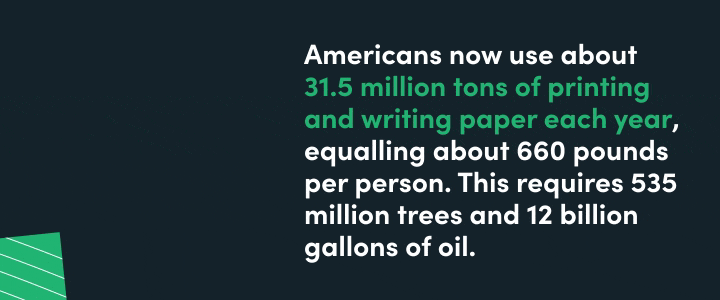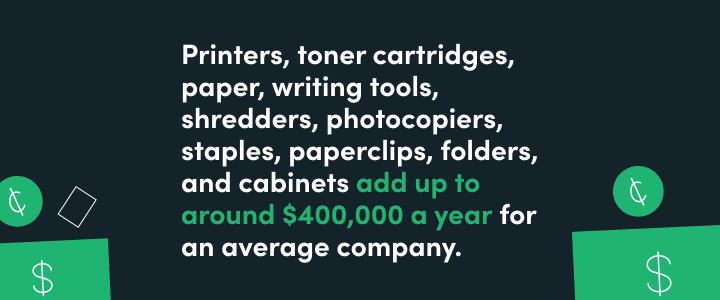In this day and age, you probably wouldn’t expect paper to be high up on the list of workplace woes.
But research and statistics say otherwise. Even though we’re living in the digital age, we’re still fighting the same battle against Big Paper.

We’re not trying to say that paper isn’t a necessity in life, but does it need to be a necessity in your workplace? Maybe not.
Paper processes are known to be costly, inefficient, and unsecure. Yet paper has infiltrated every industry and still has a strong grip on many of our everyday workflows and tasks. Why are we still letting paper derail our workdays and impact our environment?
Check out the paper statistics below to see how big the paper issue really is. From diminishing forests to costing businesses millions of dollars, paper is still causing problems across the globe.

Did you know? Formstack has helped save customers 470 million+ sheets of paper and 47,000+ trees since 2010.
Surprising Paper Statistics
Mr. Pulps–the head of Big Paper–revels in how much paper rolls out each year. The following statistics give him great joy because they prove his paper business is still sitting pretty.

The world produces 300 million tons of paper every year.
Global paper and paperboard output increased 3% between 2010 and 2019.
The worldwide paper and paperboard market is predicted to reach a worth of $5,893.9M by 2022.
The most notable increases in wood consumption by 2060 will be by the paper industry.
Worldwide consumption of paper has risen by 400% in the last 40 years, with 35% of harvested trees being used for paper manufacturing.
Facts About the Pulp and Paper Industry
Big Paper doesn’t want you to know about their Redundancy Division, which focuses on making paperwork as complicated and cumbersome as possible. They also don’t want you to know these facts about pulp and paper.
The pulp and paper industry, which makes products such as office and catalog paper, glossy paper, tissue, and paper-based packaging, uses between 33–40% of all industrial wood traded globally.
Pulp and paper is the third-largest air, water, and land polluter among all industries in Canada and the U.S.
Paper production is the third most energy-intensive of all manufacturing industries.
Over 40% of wood pulp goes toward the production of paper.
A single large pulp and paper mill can consume over 3.5 million tons of wood in a year.

The Impact of Paper in the U.S.
Does the “American Dream” include piles of paperwork? Mr. Pulps likes to think so. It’s clear that Big Paper’s mission of getting people hooked on paper is working, especially in the U.S.
U.S offices use 12.1 trillion sheets of paper a year.
The average American office worker uses an average of 10,000 sheets of office paper per year.
The U.S. is by far the world’s largest producer and consumer of paper. Per capita, U.S. paper consumption is over six times greater than the world average and about 25% greater than Japan, the world’s second largest per capita paper consumer.
Americans now use about 31.5 million tons of printing and writing paper each year, equalling about 660 pounds per person. This requires 535 million trees and 12 billion gallons of oil.

Paper Usage in Offices
Big Paper is definitely set on world domination, and they’re doing a pretty good job achieving this goal. Their products continue to cause inefficiencies–and papercuts–in offices across the globe.
The average office worker uses about four dozen sheets of paper per day, of which about half is considered waste.
70% of the total waste in offices is made up of paper, and as much as 30% of print jobs are never even picked up from the printer.
Even with the business world becoming more digitized, the average office worker generates about two pounds worth of paper and paperboard products every day.
It’s been estimated that 45% of paper printed in offices ends up trashed by the end of the day.
Office workers in the U.S. use an average of 4 million tons of copy paper annually.
25% of salespeople say paperwork is their biggest time waster.
On average, companies completely lose around 7.5% of all their paper documentation.

The Environmental Impact of Paper
While Mr. Pulps enjoys picnicking with his latest collection of paper plates and napkins, forests all over the world are disappearing. Luckily, Formstack is on a mission to plant trees to replace the ones cut down by Big Paper.
Scientists estimate that deforestation and forest degradation account for around 20% of the annual greenhouse gas emissions that fuel climate change.
80,000 acres of forests disappear every day.
From 2001 to 2019, a total of 386 million hectares of forest were lost globally. This loss represents an almost 10% decrease in tree cover since 2000.
Paper waste accounts for up to 40% of total waste produced in the U.S. each year, which adds up to 71.6 million tons of paper waste per year in the U.S. alone.
In 2018, paper and paperboard materials comprised the largest component of solid waste in the U.S.
The True Cost of Paper
Mr. Pulps loves how much paper costs companies–it’s kept his pockets lined with cash for more than 30 years. He hopes organizations never realize how much of their budget is dedicated to paper processes or how much they could save through digitization.
U.S. companies spend $120 million annually on printed documents
It costs an average of $20 to file a paper document, $120 to find misfiled documents, and $220 to recreate a lost document.
A four-drawer filing cabinet with a capacity of approximately 11,000 documents, uses nine square feet of space and costs about $1,500 per year.
Every 12 filing cabinets require an additional employee to maintain.
Paper consumption grows by 22% a year, meaning paper costs double every 3.3 years.
Printers, toner cartridges, paper, writing tools, shredders, photocopiers, staples, paperclips, folders, and cabinets add up to around $400,000 a year for an average company.

Stop Big Paper Now
Now that you know about Big Paper and the many issues they create, will you join us in stopping them? For 15 years, Formstack has worked to undo the harm Big Paper has done by eliminating paper processes, unnecessary forms, and complicated workflows. Now is the time to end Big Paper’s reign.
Join us in the fight against Big Paper by heading to stopbigpaper.com now.











